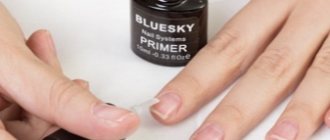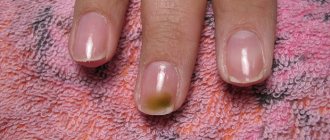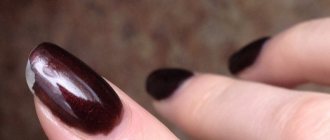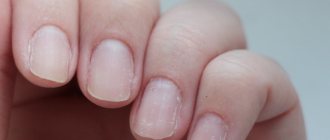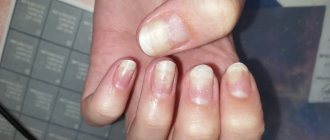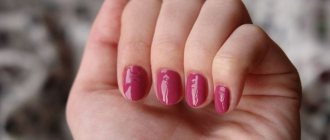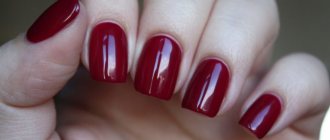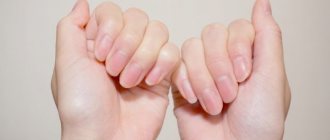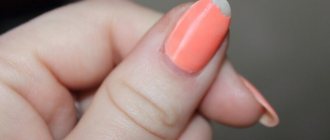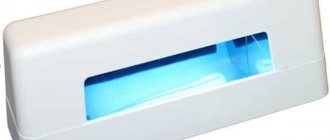Psoriasis or nail fungus?
Externally, hyperkeratosis and onycholysis (separation of the nail) in psoriasis may resemble manifestations of a fungal infection.
Therefore, it can be difficult to carry out differential diagnosis, that is, to identify the true cause of changes in the nail plate. Moreover, both psoriasis and fungus can affect the same nails at the same time. This most often occurs on the toes and is primarily characteristic of older patients.
Onycholysis and subungual hyperkeratosis in onychomycosis
The following symptoms speak in favor of psoriasis:
- oil stains and/or thimble symptom on fingernails,
- signs of psoriasis on the scalp and/or,
- periodic remissions and exacerbations of nail damage.
In favor of onychomycosis they say:
- longitudinal stripes on the affected nail,
- detection of fungi when examining a scraping from the affected nail treated with potassium hydroxide under a microscope (KOH test),
- positive culture for fungus.
You also need to remember that a fungal infection can cause Koebner phenomenon on the nail and surrounding skin, which will cause symptoms of psoriasis. So anyway
Why do nails suddenly turn black?
Fingers have a lot of nerve endings, since impulses go there, and under the nail plate the skin is equipped with many capillaries. The nail has no color and cannot darken due to injury.
The reasons for this unpleasant phenomenon are:
- Rush of blood to the finger when bruised. If a hematoma occurs, it swells and the skin on it changes color, which is best seen on the skin under the nail plate.
- Minor injuries. They can be unnoticeable - it is not necessary to pinch a finger; the reasons may lie in shoes that pinch the foot, or in a strong load on the limbs. This all applies to injuries, just in a milder form.
- Fungal infections. Formations such as favus, rubromycosis and microsporia can also occur in those who carefully monitor their health. So, following hygiene recommendations, wearing high-quality shoes, and regular manicure and pedicure procedures are not always able to fully protect you from fungus.
The color of the spots on the skin under the nail plate indicates the peculiarities of malfunctions in the body. Of course, only a professional will determine the correct diagnosis, but it’s not difficult to guess where the problem lies on your own. Problems with the digestive organs are reflected on the nail in the form of dark green spots. The skin acquires an unpleasant orange tone due to problems in the nervous system and brain. If blood does not circulate properly in the body, then the skin under the nail will have blue or black tints.
When the origins of the problem are known, eliminating dark spots is no longer so difficult. After this, your nails will return to their original color.
Important conclusions and what to do
Let us summarize important information about nail psoriasis and its symptoms.
Diagnostic features
Nail psoriasis is very common but often goes undiagnosed.
Manifestations of nail psoriasis can be minor, so even specialists often do not pay attention to it.
In 5% of cases, nail damage may be the only symptom of incipient psoriasis.
The manifestations of different diseases on the nails may look the same, which further complicates diagnosis.
The main manifestations of nail psoriasis:
- a symptom of a thimble - pits on the nail,
- white dots,
- crumbling nails,
- red dots in the hole area,
- nail detachment,
- longitudinal subungual hemorrhages,
- subungual hyperkeratosis - loose accumulations under the nail,
- oil stain symptom.
Psoriasis and fungus
- Nail psoriasis is often accompanied by a fungal infection.
- To definitely exclude it, you need to contact a mycologist and conduct additional research.
Nail psoriasis and psoriatic arthritis
Nail psoriasis is a common accompaniment of psoriatic arthritis.
It is important to detect pathological changes in joints as early as possible in order to begin treatment on time and avoid irreversible complications and disability.
Even if there are no external symptoms of arthritis, but nail psoriasis is detected, it is necessary to undergo an examination of the joints using ultrasound or MRI.
Diagnosis of the disease
First, the dermatologist examines the finger, which has a void between the finger and the nail. To understand how to cure onycholysis, it is imperative to undergo tests. At a minimum, a fungal test will determine the underlying cause of your symptoms.
If a dermatologist finds it difficult to make a diagnosis, he will refer the patient for a full examination. A detailed blood test shows the state of the body and allows the doctor to recommend the most correct and effective treatment.
How to identify fungus on toenails - common symptoms
Depending on the stage of the disease, complete atrophy and partial hypertrophy are distinguished, and both concepts are interrelated, but are not synonymous. The atrophic type refers to impaired growth, thinning and complete destruction of the nail plate - this is the stage of total damage. Often, when an advanced stage is detected, patients complain to the dermatologist not only about changes in the structure, but also about severe pain.
Hypertrophic toenail fungus - symptoms:
- acquires a yellow tint along the edge of the plate or whitish inclusions appear near the growth zone;
- deformed - waves, tubercles, and other irregularities appear;
- the cushion turns red, peels and swells as the infection grows;
- begins to exfoliate, move away from the bed;
- Small cracks and sometimes blisters appear between the fingers.
Itching and burning
Very often the disease manifests itself on the legs in the form of severe itching. This feeling begins to bother the patient from the first days after infection. If fungal spores attack the plate, itching is felt around the affected area, while the skin becomes flabby, dry and peeling, and irritation appears. If the infection started from soft tissues, the fingers themselves itch. When the skin is strongly scratched, the itching is followed by a burning sensation. As a rule, these symptoms occur with lesions of the feet, less often with onychomycosis of the hands.
Loss of natural color
This is the next symptom of onychomycosis, which replaces or complements itching. In this case, the color will depend on the type of pathogen that has settled in the human body:
- Dermatophytes provoke the appearance of yellowish spots localized near the edge. Over time, disputes spread to the central part.
- Yeast-like fungi thin the nail, starting from the sides, and it turns yellow, cracks, and furrows or waves may appear. The presence of a fungal infection at the initial stage can be determined by the ridges - they turn red, swell, silvery scales appear, and possible suppuration.
- A family of mold parasites change the shade of the nail from yellow-green to brown-black.
Loss of shine on the nail plate
Once inside the fingers, fungal spores begin to actively multiply and gradually cover the entire space, slowly leading to complete deformation and destruction of its hard part. The plate thickens or, conversely, becomes very thin, begins to crumble, and an unnatural yellowness and whitish coating become noticeable. At the initial stages of infection, the very structure of the nail plate changes - it becomes lumpy or covered with stripes, and the shade of the plate becomes cloudy.
Doctors distinguish three main stages of fungal infection:
- The color turns yellow and furrows appear. When you try to cut the edge, the tip begins to crumble. Sometimes an unpleasant odor may appear.
- The finger completely changed color, became dull and cloudy, and strange inclusions appeared. The yellowness begins to darken, black stripes appear, and areas of green may appear. Cutting off affected nails becomes very difficult.
- The entire nail has changed - it has become significantly thicker, it is impossible to trim the edge without softening.
Pain in the nail area
Discomfort with nail fungus is not a typical concept for every patient. Some patients may not experience such symptoms at all, especially if the disease was detected at an early stage. With an advanced form of fungal infection, it is easy to recognize the pathology: the fingers lose their original appearance, begin to flake and peel. At this stage, some patients may feel pain under the nail or in the fingers.
Painful sensations with mycosis of the toes can occur for several reasons:
- Due to the fact that the affected areas become thicker, lose their original appearance, and become deformed. In this case, even the most worn-out shoes cause noticeable discomfort when walking. As a result, pain can bother you not only during a walk, but also after taking off your shoes.
- As the spores spread, the fungus captures more and more new territories. When it gets into the soft nail tissue, the infection often affects the nerve endings, causing aching, paroxysmal or throbbing pain. If a symptom arises for this reason, discomfort may occur even at rest.
- One of the signs of foot fungus is the appearance of small cracks and blisters between the toes. The skin may become very red and inflamed, and the fingers may become swollen. Due to the fact that the area between the toes in closed shoes sweats a lot, such wounds on the feet heal very slowly and constantly hurt.
ONYCHOLYSIS OF NAILS: TYPES, CAUSES, SYMPTOMS AND TREATMENT. HOW ARE ONYCHOLYSIS AND GEL POLISH RELATED?
Such a common disease as nail onycholysis, along with an allergy to shellac, is the most common reason for refusing a beautiful manicure with gel polishes. Today we will tell you about the causes of this disease and its types, teach you how to recognize the symptoms and tell you which home treatment methods are most effective against nail plate detachment. We will also dispel some myths about the relationship between onycholysis and design with durable polymer coatings.
Nail onycholysis: what is it and what are the causes of the disease?
Photo by: @pedikur_kalina
Onycholysis
is a defect of the natural nail plate, which is a type of
onychodystrophy
.
With this disease, pathological changes in the color, shape and structure of the nails occur, accompanied by detachment of the nail from the nail bed. As a result of a disruption in the connection between the soft tissues and the nail, an air layer is formed, brownish-yellow, yellowish or white-bluish in color. onychomycosis
often develops in the resulting cavity .
Photo by: @podolog_fokina
Onycholysis itself is not contagious. The danger is posed by harmful microflora, which can easily be transmitted through contact from a sick person to a healthy one. Due to the nature of its occurrence, the disease most often occurs in adult women (regardless of the specific age), less often in men. It can spread to one nail or involve several fingers or toes at the same time. Risk factors that provoke the appearance and development of onycholysis can be divided into internal and external.
Internal reasons include:
- hormonal imbalances, which result in excessive production of hormones, causing defects in nail development;
- poor nutrition (deficiency of vitamins A, E, B, lack of iron);
- chronic diseases (diabetes mellitus, metabolic disorders, weakened immunity, cardiovascular or endocrine diseases);
- side effects when taking medications (antibiotics in combination with UV radiation often lead to photoonycholysis).
Photo by: @podolog_fokina
External traumatic influences can be:
- Allergic reaction to chemicals (household chemicals, contacts with chemicals in production, materials for design, gel polishes, etc.);
- Concomitant dermatological diseases that arose before the onset of onycholysis (atopy, psoriasis, eczema, etc.);
- Wearing inappropriately sized shoes. Most often, the disease affects the thumb due to regular mechanical compression and tightness. The problem is aggravated by the presence of flat feet, violation of the correct load on the foot, excessive length of nails, etc.;
Photo by: @burundukova_nails
- Domestic injuries (hitting a hard surface, pinching, using nails as “openers”). This also includes self-manicure at home: incorrect design of the side ridges (lateral or lateral onycholysis), non-compliance with extension technology, errors in cuticle processing, incorrect removal of artificial coatings in manicure or pedicure (including the use of aggressive solvents) and over-adjustment of the design ( beyond the time limits recommended by the materials manufacturer);
- Burns to the nail bed (when working with acidic chemicals without gloves or due to violation of precautions when drying coatings in a UV lamp);
Photo by: @podolog_fokina
- Prolonged exposure (contact) of nails with water without the use of gloves.
There is an opinion that onycholysis will sooner or later occur if you wear shellac constantly and without interruption. However, in practice, nail diseases after gel polish occur if low-quality materials are used, the work technology is not followed, or the coating is over-extended (failure to wear it on time provokes the occurrence of detachments that literally tear off the upper layers of the nail plate behind them). If you get a manicure from a professional manicurist who has undergone training, complies with all SanPin standards and purchases exclusively certified materials, the risk of encountering onycholysis is extremely low for you.
It is not only fake or low-quality gel polish that causes this problem.
And before you start worrying, you need to conduct a self-diagnosis of natural nails, based on the results of which you decide which specialist to contact - a dermatologist or a podiatrist. Nail detachment: diagnosis and types of disease
Photo by: @podolog_fokina
Since onycholysis is a nail pathology, self-diagnosis must be based on an understanding of what a “healthy nail” is. By this we mean a nail plate of regular shape, with a slight natural shine, a smooth surface and a pale pink color. If your nails (or the client’s nails) have grooves or grooves, a deformed free edge (in the shape of a fuzzy crescent) or inclusions, delamination or changes in the hole (increase or disappearance), an unpleasant odor or periungual itching of the skin appears, you should make an appointment with a specialist.
In the case when the void under the nail changes its structure (turns rough), pain or discomfort appears, changes in natural pigmentation or suppuration - it is necessary to be tested for a fungal infection and determine treatment methods depending on the type of onycholysis.
The disease varies in the size of the affected area and the cause of the pathology. In the area of detachment, onycholysis can be partial
or
total
.
In the first case, a small area of fungal infection is observed (a strip or semicircle), in the second case, the nail comes off completely. Total damage can occur from the area of the lateral ridges (lateral) or from the side of the free edge (distal onycholysis). Depending on the cause of the disease, the pathology may be allergic
,
traumatic
or
fungal
in nature.
Photo by: @maggic_nails
The next step after diagnosis is the selection of an individual treatment method according to the recommendations of a micrologist, podologist and dermatologist.
The sooner the patient comes to see the doctor, the greater the chances that the detachment will grow back (before the soft tissue in the resulting cavity hardens and loses its ability to adhere to the nail plate). The duration of treatment and recovery under the supervision of a specialist (in a doctor’s office and at home) can take up to six months and depends on the extent of the lesion and its nature. How to treat onycholysis?
What can and cannot be done until complete recovery? The course of effective treatment of onycholysis includes 3-4 main stages, as a result of which it is possible to significantly improve the patient’s health. What should you do when the nail comes away from the skin?
- Stage No. 1: the doctor cleans or removes the exfoliated part of the nail plate, installs a bracket for proper and quick restoration of the nail;
Photo by: @maggic_nails
- Stage No. 2: if a fungal or bacterial infection is detected, the specialist prescribes the use of antifungal drugs (disinfecting and regenerating ointments, creams, varnishes) or antibiotics (for severe forms of the disease). In addition to basic care, products are recommended for joint preventive use - to prevent relapses of the disease, strengthen nails and protect undamaged areas of the nail plate near the source of infection (for example, the drug Profit from the Rosi brand);
- Stage #3: Exposed soft tissue should be protected from further damage and the cosmetic defect should be corrected. Protective manipulations are performed if more than a third of the nail bed is open. The procedure is to apply a breathable bandage, a ready-made textile orthosis, or prosthetics with a medical hypoallergenic gel. The latter covers the soft tissue, prevents infection from entering the affected area and reduces the risk of injury, curvature and deformation of the nail bed. This gel contains special antiseptic and antifungal additives and does not cause burns or allergies. It is used only after the infection has been eliminated. You cannot use standard extension materials in this manner!
- Stage No. 4 involves stimulating the growth of a healthy nail plate and a set of preventive measures to prevent recurrent infectious complications. At this stage, all attention should be paid to eliminating traumatic factors and gentle nail care. Until the affected nails have regained their healthy appearance, you should absolutely not expose them to household chemicals (be sure to use gloves!), perform a manicure or pedicure with sharp instruments, or apply varnishes, gel polishes and other substances that can cause irritation to the nail plate.
In this review, we will take a detailed look at supportive care for restoring nails during onycholysis at home, since the prescription and use of medications (including vitamin-mineral complexes) and medical procedures can only be carried out under the supervision of a nail service specialist or doctor.
Preventative care at home may include the following:
- the use of products to stimulate nail growth (cuticle oils and creams, lotions and hand butters with a rich natural composition, nail masks) simultaneously with massage of the nail growth area at least twice a day. Use exclusively gentle products for treating the cuticle, the effect of which on the matrix area is completely safe.
As well as including Rosi Regenerator serum and Rosi powder powder in your daily care. The first remedy is a pine-provitamin concentrate, which simultaneously effectively heals connective tissue and protects the diseased nail from re-infection.
The second creates a reliable antiseptic barrier and absorbs excessive moisture (which is especially important for chronic hyperhydrolysis). Do not forget about the periodic use of products with an antifungal effect (for example, Rio Profi PNI) and nail strengthening drugs;
- the use of medicinal baths with salts and maceration (on the recommendation of a doctor - pharmaceutical preparations or ready-made products from nail brands);
- weekly correction of the length of the free edge with files for natural nails and elimination of possible risks of recurrence of the disease.
Nail plate disease: how to prevent the risk of onycholysis?
A set of preventive measures and simple restrictions will not only allow you to quickly recover from damage to your nails, but also have a beneficial effect on the health of your hands and feet in general. In addition, it is easier to prevent any disease than to treat it, enjoying the beauty and well-groomed hands and legs, their attractive appearance.
So, the checklist for proper skin and nail care includes the following tips:
- try to choose the right shoes: they should not rub the foot, squeeze it or disrupt the biomechanics when walking;
Photo by: @mari_nail.yar
- regularly perform manicures and pedicures with sterile instruments - at home or in a trusted, certified salon. When processing yourself, file the free edges of the nail plate only in one direction to avoid delamination;
- avoid excessive length of nails, as this is not only a stress factor for the nail bed, but also a risk of injury;
- Wipe your feet and hands thoroughly dry after washing (to avoid the risk of developing a fungal infection), regularly apply moisturizing and nourishing creams, lotions, oils, and periodically masks to the skin and nails. For problem nails - use a course of Ibx from Famous Names, SSN from Rip Profi or Vitagel Strength and Vitagel Recovery from Gelish Harmony;
- give up the bad habit of biting your nails (El Corazon anti-biting product will help you with this) and save on the use of design materials (along with removers). Choose well-known manufacturers whose products undergo strict testing and certification!;
- do not be lazy to always wear protective gloves when working with household chemicals, prolonged contact with water, detergents and chemical reagents;
Photo by: @nails_kabinka
- balance your diet and set aside time for regular preventive examinations with a dermatologist and podologist; if there is a risk of onycholysis at work, have preventive and therapeutic medications for course use in your home medicine cabinet.
By following these recommendations, you can significantly improve the health of your nails, prevent the risks of developing nail diseases and not deny yourself the opportunity to wear spectacular gel polish designs of almost any degree of complexity.
About the disease
Onycholysis is a disease in which the integrity of the nail plate is damaged, and the nail itself is partially or entirely separated from the bed.
This is easy to notice by the change in color, when the exfoliated area becomes identical in shade to the edges.
In some cases, the color may vary from bluish to burgundy.
At the initial stages, the peeling is not too noticeable, but gradually the damaged surface grows.
Based on the size of the lesion, onycholysis is divided into complete and partial. The choice of treatment method and specific drugs depends on the cause of the disease.
Main symptoms
The main sign that something is wrong with the nails is peeling at the edges of the plate. Gradually, the process can even reach the base of the nail, in which case there is a high risk of losing it completely.
In addition, you may notice other symptoms:
- uneven nail thickness, unevenness on the surface;
- color change;
- painful sensations;
- redness;
- purulent discharge;
- brittle nails;
- hematomas;
- bleeding.
Onycholysis is often confused with a fungus because the external symptoms may be similar. However, this disease has differences from a fungal infection:
- Onycholysis itself is not contagious unless it is caused by an infection.
- With fungus, the nail plate first changes color, becomes thicker, and then in the final stages begins to peel off. Onycholysis begins precisely with exfoliation.
- A fungal infection causes itching and redness.
- Nails affected by fungus have an unpleasant odor, which is absent in non-infectious onycholysis.
- The cause of fungal diseases is the activity of pathogenic microflora, while onycholysis is often caused by other reasons - trauma, pathological changes in the body, etc.
However, there are situations when both diseases occur simultaneously. Therefore, at the very first symptoms, you need to see both a dermatologist and a mycologist.
Based on the test results, it is already possible to make a correct diagnosis and choose the appropriate treatment.
Advantages and disadvantages of gel polish, shellac
The invention of long-lasting varnishes was a real breakthrough in the beauty industry. Women have forgotten the time when manicures had to be fixed every evening. Gel polishes were liked by masters and millions of clients. Manicure has ceased to be a privilege for those with strong nails. New nail art technology has made many girls happy. Beauty no longer “requires sacrifice.” Among other benefits, gel polish provided the following opportunities:
- Retains its original appearance for up to two to three weeks;
- Resistant to aggressive environments;
- Allows you to have nails of any length;
- Has high strength.
The disadvantages of new technologies, like other discoveries, were not immediately discovered. The rosy reality was darkened by negative consequences, many of which required painstaking restoration of nails after shellac. Beauty, even artificial, “required sacrifice.”
Gel polish, acrylic and shellac - find the differences
It would be a mistake to consider shellac and gel polish as products of different categories. The first took the name from the leading brand -. The composition of these products is almost identical and absolutely safe for nails. The slight difference is in the method of adhesion to the nail plate, which explains the differences in the preparatory part of the procedure. The old varnish is removed only after prolonged exposure to acetone, which slightly softens the film. If shellac peels off easily, then the gel and acrylic have to be filed off with a nail file.
The widely advertised safety and protective properties are completely offset by the aggressive nail polish removal procedure:
- Prolonged exposure to acetone dehydrates the cuticle and nail plate. Dry nails become brittle and peel easily;
- Mechanical impact completely destroys the protective layer, injures the cuticle, opening access to pathogenic bacteria and fungi.
Prolonged isolation and subsequent traumatic effects do not pass without leaving a trace. Opened nails look lifeless, completely devoid of natural thickness and smooth structure. At this moment of revelation, I am asked if this should be the case.
How to treat nail dystrophy at home
Treatment of nail dystrophy on the fingers and toes should be agreed with a doctor
He is obliged to take into account all the characteristics of the patient’s body. Therapy for such a disease always has an integrated approach and is aimed at determining the cause of the pathology and its relief, regenerating the trophism of the nail and tissues around it
It includes the use of ointments, drugs, traditional recipes or surgery.
Treatment with medications
Treatment of dystrophic changes in the nail plates with the help of medications involves the use of two groups of medications: sedatives and drugs that block the sympathetic nervous system. Only it sends impulses to the sweat glands. Sweating plays a major role in the body's thermoregulation. With frequent sweating, local swelling of the skin occurs, for example, around the fingers. The result of this process can be dystrophy of the nail plate.
Therapy for such a pathology should be carried out directly under the guidance of a doctor, because many of the available drugs have contraindications and side effects. The following medications will help eliminate all manifestations of dystrophy:
- Valerian, motherwort can be prescribed in the form of medicine, herbal preparations or homeopathic preparations.
- During the initial development of the disease, antiperspirants are used (medicines actively used to treat conditions associated with anxiety, bad mood, apathy, emotional stress, melancholy). Their action is aimed at narrowing the channels through which sweat penetrates the skin. The result of this treatment of fingernails and toenails is the normalization of sweating.
- Angioprotective (vascular protective) drugs. They help improve microcirculation in the tissues of the hands and feet. Effective drugs with this effect are Detralex and Endotelon.
Mineral and vitamin complexes to increase the body’s content of vitamins B, A, E, sulfur, selenium, calcium.
Folk remedies
Treatment of nail dystrophy may include traditional methods. They are used primarily as adjunctive therapy. Thanks to the local use of traditional medicine, it is possible to restore damaged nails in a short time and normalize the nutrition of the periungual tissues. Treatment of nail plate dystrophy with folk remedies includes the following recipes:
- Iodine. Treat your nails with 5% iodine tincture 2 times a day. The duration of therapy is 10 days, then a break for 2 days, and then repeat the course again.
- Propolis. Use a 20% tincture for compresses at night. During application, you must avoid getting the product on the skin, otherwise it will cause a burn. Number of procedures – 2-3.
- Baths. They have a good effect on nail deformation. Sea salt is used to prepare baths. A tablespoon of the substance is diluted in a glass of warm water, and then poured into a container and immersed in the solution for 10-15 minutes. After the procedure, they must be dried with a soft towel and natural wax rubbed into the skin.
Traditional methods of restoring nails
There are many homemade ways to strengthen nails, practiced by more than one generation of fashionistas. Most popular:
- Salt baths . Several times a week, do a 15-minute hand bath with sea salt. The solution is rich in minerals and has disinfecting properties due to the presence of iodine;
- Oil baths effectively moisturize the skin, cuticles, and nails. A couple of drops of vitamin A are added to the warm oil. After the procedure, thermal gloves are put on your hands;
- Iodine and garlic can be found in every home. They are used topically by rubbing the nails before bed.
There is no one way to help everyone equally. Nails deteriorate for various reasons. They become especially vulnerable in the off-season and cold season.
Restoring nails after pregnancy and childbirth for a nursing mother using gel and shellac should be done quickly, since the female body undergoes enormous changes during pregnancy and after birth. Loss of calcium and other substances leads to deterioration of nails and hair. Folk remedies and a balanced diet will help correct the situation. It is better to avoid cosmetic and pharmacological drugs while breastfeeding.
You cannot postpone caring procedures. A child requires a lot of attention and this will not change with age. It is enough to give yourself half an hour a day to catch up. Vitamin greens, natural broths and regular nutrition will speed up the recovery of a depleted body.
Prevention methods
Due to the fact that Pseudomonas aeruginosa is resistant to a large number of disinfectants, disease prevention is somewhat more complicated.
- In public places, such as swimming pools or hotels, when interacting with water, it is best to have personal slippers with you.
- Do not walk barefoot on beaches, public baths and saunas.
- Do not use someone else's manicure tools or use someone else's towel.
- Use gloves when working in the garden.
- Shoes should be loose and made from natural materials.
Those who often spend time in public baths or swimming pools have a high risk of contracting Pseudomonas aeruginosa.
In such cases, you should pay attention to antifungal drugs for treating feet.
Fingernails and toenails infected with pseudomonia and “blooming” with greenery are not only an aesthetically unpleasant sight, but also pose a great danger to health. Do not delay treatment; consult a doctor on time to avoid additional complications.
Lack of vitamin D and calcium
If the body lacks vitamins and microelements, the nails will also peel off. Therefore, it is worth monitoring the level of these microelements. Vitamin D deficiency can be recognized by external signs:
- pain in muscles and joints;
- increased fatigue;
- digestive problems and others.
Calcium deficiency is usually recognized quickly by brittle nails and dental problems.
Vitamins for beauty. How to improve the condition of your skin, hair and nails Read more
How to recognize fingernail and toenail fungus at home?
General recommendations
Determining the characteristic symptoms and using home methods to identify the pathogen will help you accurately diagnose foot and nail fungus. To do this, you need to carefully monitor the manifestations of the disease. At the first stage of infection, a fungal disease (mycosis) can be confused with manifestations of lichen or psoriasis
It is important to learn and remember the main differences between mycosis and these ailments so that you can recognize it yourself
Symptoms
The main signs of fungal nail infection, which differ from other skin diseases:
If your nails are splitting or turning yellow, these may be symptoms of nail fungus.
Dry and brittle nails, thickening and layering.
Method with potassium permanganate
If there are changes in the nails on the fingers or toes, you can check at home and understand whether there is an infection on them or not. To do this, you will need a container of warm water and manganese. Procedure:
- Make a weak solution of potassium permanganate.
- Immerse your limbs in the liquid for 2-3 minutes.
- When your nails are painted yellow, your nails are healthy. Infection is present if the nail plates remain the same color.
Uses of iodine
The pharmaceutical product, iodine, does not detect the fungus itself, but it is no less effective in helping to recognize skin diseases at the initial stage of development. For example, with the help of iodine, it is possible to distinguish and identify pityriasis versicolor, which affects the skin of the extremities. If there are suspicious signs similar to this disease, it is enough to apply the product in a thin layer, wait for 2 minutes and look at the result. If you have existing skin problems, the affected areas will have a rich color. Healthy areas of the dermis remain outwardly pink and do not stand out in any way.
Mold on the nail under the gel? What is this? Photo
Masters in beauty salons can save on materials. This will lead to problems with the health of the nails - detachment of the artificial nail plate from the natural nail.
Moisture accumulates in the resulting pocket, and mold appears on the nail under the gel. What is this and how to fix it? Photos allow you to clearly see what this defect of an incorrectly performed procedure looks like.
The natural nail plate may become deformed. A woman should monitor the condition of her new nails.
IMPORTANT: If mold appears under the extended nails, then you need to go to the salon and have them removed.
If this is not done in a timely manner, the disease onycholysis may develop. The nail will change its color, and then recovery and treatment will take at least six months. In addition to mold, stains from ingrained materials may appear. Only a qualified technician will be able to determine the cause and origin of green spots on the nail plate.
Ingrown toenails: photos and treatment
Ingrown nails are a common occurrence. Ingrowth of the outer or inner edge of the nail plate into the tissue of the lateral nail fold initially causes hyperemia, swelling of the periungual fold, moderate pain when walking, and then there may be pyogenic granuloma and complications such as paronychia, lymphangitis, erysipelas, phlegmon, osteomyelitis.
In non-advanced acute cases, conservative treatment methods consist of placing a swab (strip) of gauze soaked in 5-10% synthomycin emulsion or ointment under the edge of the nail
"Levomekol", "Levovinisol"
Vishnevsky ointment, Solcoseryl
Rivanol lotions and lubrication with Castellani liquid (fukortsin) are also considered effective.
Proper selection of shoes, hygiene, proper trimming, treatment of excessive sweating are mandatory measures for ingrown toenails and other pathologies of toenails.
Heliomycin ointment
Onychopathology, i.e. changes in the shape, transparency, composition, apparatus, and pigmentation of nails indicate metabolic disorders, diseases of internal organs, and are often signs of certain syndromes and genodermatoses.
Treatment of onycholysis
Treatment should be comprehensive, especially for advanced cases. First, the doctor conducts an examination and the necessary examinations to determine the causes and contributing factors in the development of the pathology.
Among the means and methods of general influence, physiotherapeutic procedures, massage, probiotics, and angioprotectors are used. In addition, yeast extract, amino acid and vitamin-mineral complexes for oral administration are recommended, containing:
- vitamins of group “B”, stimulating metabolic processes, improving the function of peripheral nerves, etc.;
- antioxidant complex in the form of vitamins “A”, “E” and “C”, beta-carotene, which stimulates regeneration processes;
- macro- and microelements, especially with a high content of calcium, sulfur, zinc, copper and iron.
Local treatment at home consists of cutting off a section of the nail at its edge. Solcoseryl in the form of an ointment or gel helps to get rid of onycholysis. This drug, which improves blood circulation in tissues, has angio- and cytoprotective, antihypoxic, membrane-stabilizing and regenerative properties.
In the presence of a fungal infection, antimycotic drugs Mikospor, Lotseril, Ketonazole, Intraconazole, Batrafen are used topically. But the most effective (in the presence of a fungal infection) is the treatment of onycholysis with Exoderil, which in the form of a solution or cream is applied to the affected area and surrounding areas twice a day. The duration of therapy with this drug depends on the speed of recovery of the nail plate. The maximum course of treatment for hands is 6 months, for legs - from six months to 1 year. If the course is persistent, it is necessary to use antifungal agents not only locally, but also systemically.
Other emulsions and ointments are also used for onycholysis. Thus, for the purpose of prevention or in the presence of a bacterial (streptococcal and/or staphylococcal infection), synthomycin emulsion or heliomycin ointment is most often used, which are applied to the bed at the site of nail detachment and to the affected areas of soft tissue up to twice a day. Levomikol and Vishnevsky ointment, containing castor oil, birch tar and xeroform, have good antiseptic and regenerating properties.
How to treat fungus
Treatment for fungus in children is different from the therapy that works in adults. When selecting a treatment regimen for young patients, a specialist must ensure that it is as safe as possible, but at the same time effective. In case of a complex course of the disease, the doctor may recommend a full examination in a hospital setting to exclude the presence of concomitant infections and problems that can cause complications and hinder a quick recovery.
Medications
Fungal skin diseases in children are treated with antifungal, antiparasitic and anti-inflammatory drugs. Depending on the location of the fungus and the advanced stage of the disease, the doctor may recommend complex treatment using several drugs or monotherapy.
Complex treatment includes the following drugs:
- antifungal;
- hormonal;
- antihistamines;
- immunostimulants;
- vitamin complexes.
In this case, along with tablets, it is necessary to use ointments and gels that will help increase the effectiveness of the course. Fungus in children on their toes or hands will go away faster if, in parallel with taking tablets that fight pathogenic microflora inside the body, you use topical treatment products (ointments, gels).
The affected areas must be lubricated 2-3 times a day (in the morning and evening necessarily). Usually the course of treatment lasts at least a month. For systemic therapy, doctors often use the following drugs: Diflucan, Terbinafine, Griseofulvin.
For lichen in a child, it is recommended to use ointments that contain zinc, tar and salicylic acid. In advanced cases of skin infections that develop against the background of a fungus, hormonal therapy may be required.
If yeast is found on the child’s mucous membranes, it is necessary to include Monistat or Mycelex suppositories in the course of treatment.
Traditional medicine recipes
Baths with sea salt composition are an effective folk remedy for fungal infections
You can cure toenail fungus in children, on the hands and mycosis on different parts of the body using traditional medicine recipes. This method, in addition to its effectiveness, is safe, but also long-lasting. How to treat fungus in children with folk remedies? Use the following recipes to help get rid of unpleasant symptoms without causing additional harm to your health.
- 20 grams of crushed celandine herb are poured with a liter of boiling water and left for about an hour. After this, the product is additionally heated before use. They moisten a natural cloth or cotton swab and wipe the affected areas of the skin. If fungus is diagnosed in children on the toes or hands, the infusion is used for baths. The affected limbs are lowered into it for 10-15 minutes;
- natural liquid honey. A liter of honey is diluted in 10 liters of water and the solution is used as a lotion on the affected areas of the skin;
- herbal baths. To prepare medicinal infusions, it is recommended to purchase sage, oak bark, chamomile and St. John's wort at the pharmacy. Each herb is used separately. You need to take 20 grams of the herb and pour a glass of boiling water over it, then bring the medicine to a boil and remove from the heat. After the herb has been infused for a quarter of an hour, it can be used for compresses and baths;
- sea salt baths. To prepare the composition, take warm water in which 4-5 tablespoons of sea salt are dissolved. The temperature of the solution must be selected at such a temperature that you can soar your feet in it for 15 minutes without severe burning or discomfort;
- Tea tree oil works as a powerful antifungal and anti-inflammatory natural remedy. Lightly soak a cotton swab with oil and lubricate the affected areas of the skin. Thus, fungus on the hands of children is well treated when you do not want to use toxic ointments.
Antifungal diet
We have figured out what is the best way to treat a child’s nail fungus, but in parallel with local and drug treatment, the doctor will advise you to follow a special diet that will help defeat the fungus faster. The child's daily diet should include:
- fresh vegetables and fruits;
- seeds;
- chicken eggs;
- fermented milk products.
Minimize sweets and even try to put less sugar in tea. Junk foods and heavy fatty foods will cause additional harm to the body and delay treatment. It is advisable to completely exclude the following from the child’s menu:
- fresh baked goods;
- yeast baked goods;
- sweets;
- milk.
These products create a breeding ground for the development of pathogenic microorganisms and inhibit the treatment process.
The key to health is adherence to technology
In the hands of a professional master, your nails do not suffer from a super-resistant manicure. It is important to know what should not happen during the procedure in order to maintain a healthy plate:
- Excessive grinding;
- Skin injury followed by bleeding;
- Using a metal stick to remove old gel;
- Use of low-quality products and tools;
- Excessively high UV lamp power.
Most of the negative consequences are observed among clients of inexperienced professionals. Tactfulness at the expense of health and budget is inappropriate here. You need to urgently change the technician if:
- Extended manicure causes discomfort;
- The new gel quickly became cracked;
- Uneven gel thickness, depressions and bumps;
- The coating partially peeled off in the first days.
A one-time failure rarely has critical consequences if measures are taken in time.
Only a highly qualified specialist is able to apply a high-quality decorative coating so that before the next visit the nail plate has time to grow by a quarter.
Constant renewal of fabrics along with the right technology makes it possible not to sacrifice health for beauty.
A good master can give you a long-lasting manicure without any recovery breaks. Otherwise, you will have to go through a long recovery of your nails after gel polish.
Causes of nail burns after manicure:
- Chemical exposure. It is easy to assume that not all bases are the same. In their quest to optimize costs and increase profits, manufacturers use various cheap components that have an adverse effect on the nail apparatus. Due to the relative novelty of gel polish technology, today it is not precisely established which substances cause a chemical burn to the nail bed, however, a trend is clearly visible in relation to individual manufacturers. In our practice, we have not encountered bases that would never cause burns and onycholysis, just as this would happen in most cases. Individual predisposition also appears to play an important role.
- Thermal impact. Very often, patients who come to an appointment with a nail burn say that during a manicure in the salon they felt a “burning sensation under the lamp” stronger than usual. Heating causes denaturation - a change in the protein structure in the cells and intercellular space of the nail bed, onychoblasts - the cells responsible for the attachment and growth of the nail - are damaged, and the nail peels off. Typically, the development of a burn is caused either by improper use of a UV or LED lamp (too much power or duration of exposure), as well as by an excessively applied base layer.
